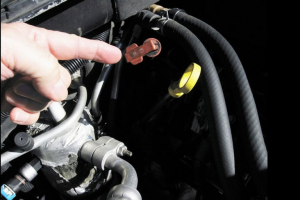The car’s transmission is built to endure harsh operating conditions, yet mechanical or electronic failures can occur. Therefore, when the transmission warning light comes on, users should take immediate action to prevent damage.
The sudden illumination of the transmission warning light indicates that something is not right with the vehicle’s transmission. This warning is usually indicated by a gear-shaped symbol with a thermometer, a gear with an exclamation mark, or a specific text displayed on the dashboard.
There are several underlying reasons behind the transmission warning light turning on. It’s important to note that this warning doesn’t necessarily mean the transmission is damaged but serves as a reminder of a potentially harmful factor, which can often be summarized into some common causes:
- Low transmission fluid: One of the most common causes triggering the transmission warning light is a low transmission fluid level. To rectify this issue, the vehicle owner needs to replenish the appropriate transmission fluid compatible with their vehicle’s transmission and locate the source of any leaks.
- Overheating transmission: Overheating of the transmission system can occur in most car types and lead to the illumination of the transmission warning light. In this case, it’s crucial to assess the overall level and quality of the transmission fluid in the vehicle and follow the manufacturer’s recommended maintenance schedule for fluid replacement.
- Stored error code: In many instances, a car’s transmission warning light will illuminate if a specific error code related to the transmission has been stored. The precise source of such codes could range from internal transmission malfunctions to simple electrical issues within the transmission’s valve body.
- Mandatory maintenance: In certain specific cases, the illumination of the transmission warning light may not be indicative of a problem. Instead, some car manufacturers use this light to signal the need for routine maintenance specific to the transmission.
What to do when the transmission warning light turns on?

When driving and the transmission warning light comes on, the immediate action is to safely pull over to the side of the road. Before shutting off the engine, use a dipstick to check the transmission fluid level. If the vehicle has accessible transmission fluid, top it up, but ensure not to overfill.
Next, the user should determine whether to call for roadside assistance or drive to the nearest service center. If severe oil leaks are discovered, calling for assistance to transport the vehicle to the intended repair destination is advisable.
In case of no oil leaks, the driver can continue to operate the vehicle but should not drive at high speeds. In some luxury car models, the manufacturer might limit engine RPMs or speed to prevent excessive stress on the transmission.
Ignoring this and continuing to use the vehicle for an extended period can result in serious transmission damage and reduce its lifespan.
To prevent damage, the causes of the illuminated transmission warning light need to be carefully diagnosed and rectified as soon as possible. Choose experienced and reputable garages specializing in transmission repairs for these services because repair and replacement of transmission components can be costly when breakdowns occur.












